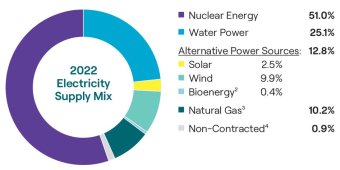OffGridForGood
Catch, make or grow everything you can.
I have been watching to see what the Ontario Utility (Hydro-One) Rates will be,
Since the Inflation over the last while I wondered what would be coming down the line.
They surprised me, with a new set of rates that will be offered - customers can choose if they want the new deal I am told.
The new deal increases the On-peak rate, a few cents,
holds the mid-peak rate the same
and dramatically cuts the off-peak rate, but shortens it's hours from 12 hours to 8 hours per night.
On peak was 15.1 now going to 24.0 cents/kWh (and fewer hours will have this rate apply: 4-9 pm weekdays only)
Midpeak stays at 10.2cents/kWh (no change)
Off peak was 7.4 but now going to 2.4 cents/kWh (in USD this is 1.8 c/kWh)
{FYI: all these rates are for energy used, there is also a fixed 'delivery' cost added to hydro bills as well}
Anyone with batteries and an inverter can load-shift to literally pay 10% of the peak rate/ 25% of the midpeak rate.
They are specifically calling for EV owners to charge 11:00PM to 7:00AM to get this super low rate, and avoid adding extra load during the peak time of the day.
I wonder how this affects the incentive to move to Solar, these new rates are optional, you don't have to use this plan. But that 2.4C rate is only available if your in this plan.
I can see people building an entire system around load shifting and skip the PV all together.
For me it is great news for next winter, since my use of Utility power is mostly Nov - early January, and I already have off-peak only battery charging set up with my system. This new ultra low rate will cut 75% off of what I pay now for winter charging of batteries, and allow EV charging at night when PV is not able to provide enough energy.
Ultimately since it is optional, you can be sure those that opt-in are going to be planning on using that low low overnight rate, even electric resistance heating/heat pumps will be attractive at that price point.
Since the Inflation over the last while I wondered what would be coming down the line.
They surprised me, with a new set of rates that will be offered - customers can choose if they want the new deal I am told.
The new deal increases the On-peak rate, a few cents,
holds the mid-peak rate the same
and dramatically cuts the off-peak rate, but shortens it's hours from 12 hours to 8 hours per night.
On peak was 15.1 now going to 24.0 cents/kWh (and fewer hours will have this rate apply: 4-9 pm weekdays only)
Midpeak stays at 10.2cents/kWh (no change)
Off peak was 7.4 but now going to 2.4 cents/kWh (in USD this is 1.8 c/kWh)
{FYI: all these rates are for energy used, there is also a fixed 'delivery' cost added to hydro bills as well}
Anyone with batteries and an inverter can load-shift to literally pay 10% of the peak rate/ 25% of the midpeak rate.
They are specifically calling for EV owners to charge 11:00PM to 7:00AM to get this super low rate, and avoid adding extra load during the peak time of the day.
I wonder how this affects the incentive to move to Solar, these new rates are optional, you don't have to use this plan. But that 2.4C rate is only available if your in this plan.
I can see people building an entire system around load shifting and skip the PV all together.
For me it is great news for next winter, since my use of Utility power is mostly Nov - early January, and I already have off-peak only battery charging set up with my system. This new ultra low rate will cut 75% off of what I pay now for winter charging of batteries, and allow EV charging at night when PV is not able to provide enough energy.
Ultimately since it is optional, you can be sure those that opt-in are going to be planning on using that low low overnight rate, even electric resistance heating/heat pumps will be attractive at that price point.




